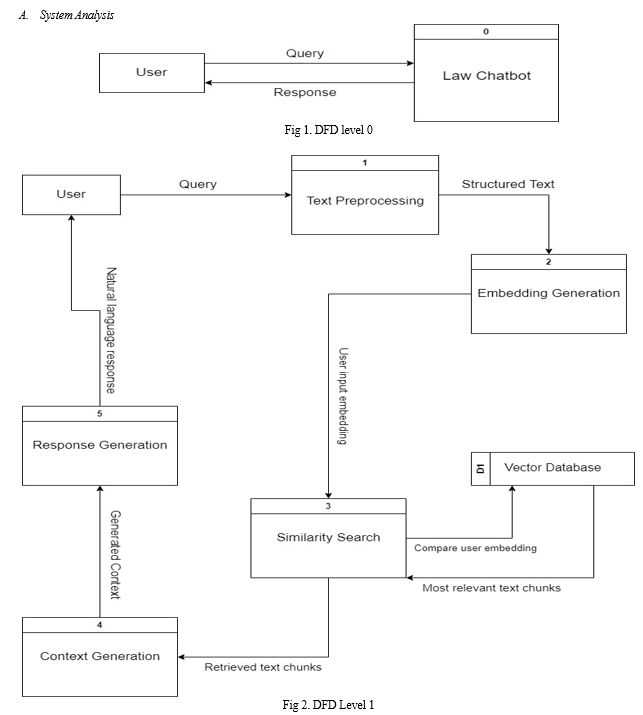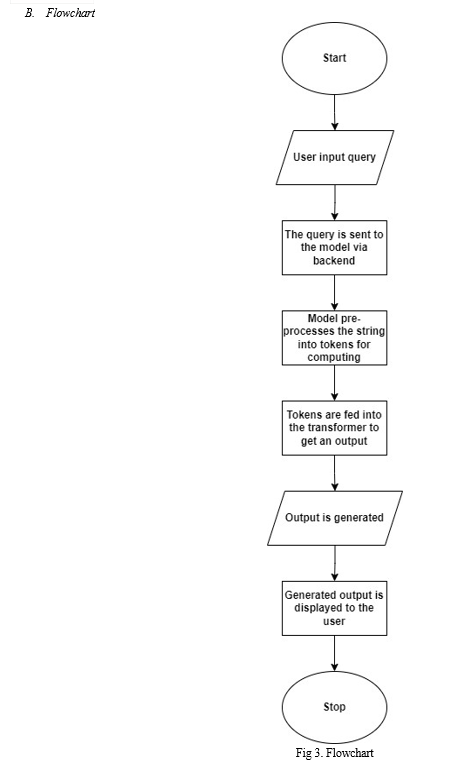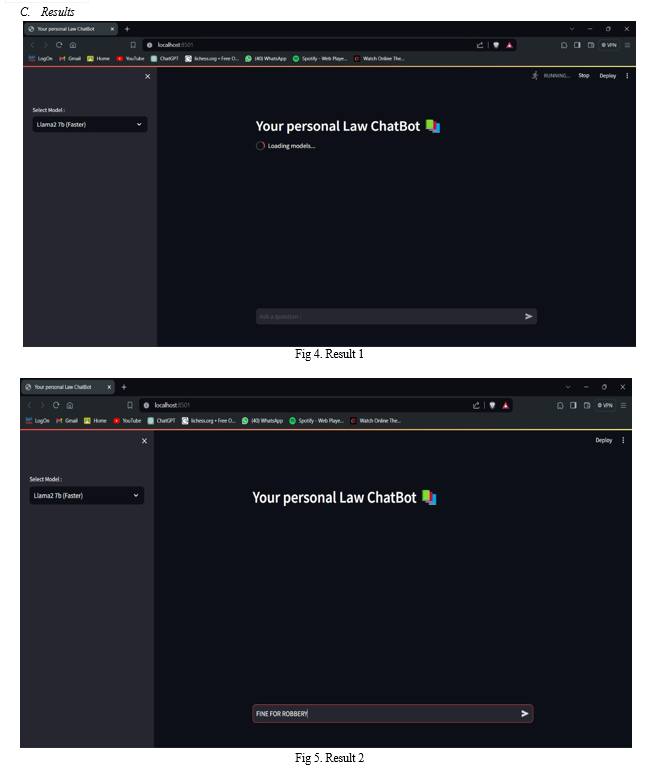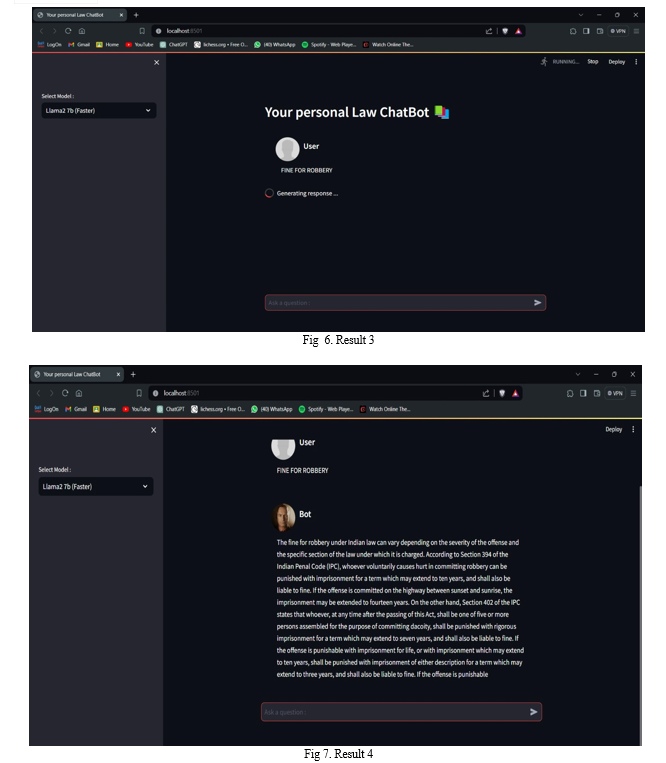Ijraset Journal For Research in Applied Science and Engineering Technology
- Home / Ijraset
- On This Page
- Abstract
- Introduction
- Conclusion
- References
- Copyright
Law Chatbot
Authors: Zivan Misquitta, Ashish Sawant, Arbaaz Shaikh, Anurag Patil, Prof. Nilambari Narkar
DOI Link: https://doi.org/10.22214/ijraset.2024.61361
Certificate: View Certificate
Abstract
This paper presents the development and implementation of a pioneering solution titled “Law Chatbot” aimed at revolutionizing access to legal information and services. The Law Chatbot is an artificial intelligence-powered conversational agent designed to provide users with instant legal advice, guidance, and resources. Leveraging text retrieval and generation, the chatbot offers personalized responses to user queries, covering a wide spectrum of legal topics such as civil law, criminal law, contract law, and intellectual property rights. The system is built upon a scalable and secure architecture, ensuring reliability and confidentiality in handling sensitive legal matters. Through seamless integration with messaging platforms and web interfaces, the Law Chatbot provides round-the-clock accessibility, empowering individual and businesses to navigate complex legal issues efficiently and affordably. With its user-friendly interface and comprehensive knowledge base, the Law Chatbot represents a transformative tool in democratizing access to legal expertise, bridging the gap between legal professionals and the general populace. This report elucidates the design principles, technical components, and potential applications of the Law Chatbot, highlighting its significance in promoting legal literacy, fostering legal empowerment, and facilitating access to justice in the digital age.
Introduction
I. INTRODUCTION
Despite advancements in technology, access to legal information and services remains a significant challenge for many individuals and businesses. The current state of the art in legal assistance primarily relies on traditional methods such as consulting legal professionals, accessing legal libraries, or searching through online resources. However, these approaches often present barriers such as high costs, limited availability, and complexity in navigating legal terminology and procedures. Moreover, the vast volume of legal documentation and the dynamic nature of laws and regulations further complicate the process of obtaining timely and accurate legal advice. In this context, the problem at hand is the lack of accessible, affordable, and efficient means for individuals and businesses to obtain legal guidance and support. Existing solutions, including legal aid programs and online legal forums, often fall short in providing comprehensive and personalized assistance tailored to the specific needs of users. Moreover, the reliance on human intermediaries for legal consultations can lead to delays, inconsistency in advice, and limited scalability.
A. Motivation
The development of the Law Chatbot is motivated by the pressing need to democratize access to legal expertise by overcoming barriers such as cost, complexity, and limited availability of legal professionals. By leveraging artificial intelligence and natural language processing, the chatbot provides instant and affordable legal advice, guidance, and resources to individuals and businesses, regardless of time or location. Through seamless integration with messaging platforms and web interfaces, the Law Chatbot ensures round-the-clock accessibility, empowering users to navigate complex legal issues efficiently and confidently. By promoting legal literacy, fostering legal empowerment, and facilitating access to justice in the digital age, the Law Chatbot represents a transformative tool in bridging the gap between legal professionals and the general populace.
B. Existing System
There are Rule-based law chatbots that rely on predefined sets of rules, logic, and patterns to interpret user queries and generate responses, drawing from structured knowledge bases containing legal rules, statutes, and FAQs. While offering advantages like simplicity and transparency, they face constraints such as limited flexibility in handling complex queries, difficulties in accommodating natural language variability, and challenges in maintenance and scalability. Moreover, they often struggle with complex legal reasoning and lack the ability to learn from user interactions, unlike machine learning-based counterparts. Thus, while rule-based chatbots provide a straightforward approach to legal assistance, their shortcomings highlight the necessity of exploring alternative approaches like machine learning-based systems, which can better emulate human-like understanding and adaptability.
C. Objectives
The main objective of this project is
- Develop a user-friendly interface accessible via web browsers and mobile devices across various platforms.
- To Curate a comprehensive knowledge base covering common legal topics and FAQs.
- To utilize text retrieval and generation for accurate understanding and prompt responses.
- To offer free or low-cost access to basic legal information and assistance to ensure affordability.
- To measure and track the impact of the Law Chatbot in terms of increased access to legal services and user empowerment.
II. LITERATURE REVIEW
In paper [1], LAW-U is an AI chatbot specifically designed to offer legal assistance to survivors of sexual violence by suggesting the most relevant Supreme Court rulings based on their circumstances. The name "LAW-U" in Thai, similar to "I will wait for you," symbolizes the chatbot's unwavering support for users. Development of LAW-U involved analyzing 182 Thai Supreme Court cases related to sexual violence, focusing on Sections 276, 277, 278, and 279 of the Criminal Code. Natural Language Processing (NLP) pipelines were constructed based on these cases, with legal experts crafting sample dialogues derived from Supreme Court decisions to train LAW-U. To enhance accuracy, similarity scores and percentages of shared keywords and synonyms were computed.
In paper [2], it delves into the copyright and personal data protection challenges associated with chatbot development, building upon existing research and expanding upon it. The authors primarily concentrate on constructing models for chatbots prior to their deployment, drawing insights from EU regulations and Estonian law to illustrate legal requirements. This interdisciplinary approach merges legal and technological perspectives, offering a comprehensive analysis of the subject matter.
Paper [3] discusses about ELIZA, a program operating within MIT's MAC time-sharing system, facilitates natural language conversation between humans and computers. It analyzes input sentences using decomposition rules triggered by key words. Responses are then generated using reassembly rules linked to specific decomposition rules. ELIZA addresses technical challenges such as identifying key words, discovering minimal context, selecting appropriate transformations, generating responses without key words, and enabling editing capabilities for ELIZA "scripts". The paper also discusses psychological aspects pertinent to the ELIZA approach and outlines potential future developments.
III. SYSTEM REQUIREMENT
A. Hardware Requirements
- CPU: i5 10th Generation.
- Ram: 16GB
- Storage: 20GB (For chat models)
B. Software Requirements
- PC or a laptop with internet access and basic drivers installed.
- Operating system: Windows 10
- Python version: Python 3.x is the recommended version with necessary requirements and libraries.
IV. PROPOSED SYSTEM
The proposed system is designed to streamline the process of accessing legal information and assistance through an AI-powered chatbot. It begins by creating a comprehensive knowledge base comprising various legal documents, including laws, regulations, case precedents, and legal articles. These documents are ingested and processed, often from PDFs or text formats, to construct the knowledge base. Next, NLP techniques such as tokenization, stop word removal, stemming, and lemmatization are applied to pre-process the legal documents, converting them into a structured format suitable for analysis. The pre-processed documents are then converted into numerical vector representations called embeddings using embedding algorithms like SentenceTransformer and HuggingFace Embeddings. These embeddings, along with their corresponding text chunks, are stored in a vector database like FAISS, optimized for efficient similarity search and retrieval.
When a user interacts with the chatbot by asking a question or making a query, their input text undergoes the same preprocessing and embedding techniques as the knowledge base. The chatbot then performs a similarity search by comparing the user's input embedding with the embeddings stored in the vector database, using metrics like cosine similarity or Euclidean distance. The most relevant text chunks from the knowledge base are retrieved based on their similarity to the user's input.
These retrieved text chunks are combined with the conversation history to generate context for a language model, such as LlamaCpp, to understand and respond to the user's query. Finally, the generated response is presented to the user through the chatbot interface, allowing for additional clarification or follow-up questions.




V. ACKNOWLEDGEMENT
We would like to express our special thanks and gratitude to our teacher, Prof. Nilambari Narkar, as well as our principal, Dr. Y.D. Venkatesh, and Head of Department, Dr, Kunal Meher, who gave us the golden opportunity to do this wonderful project on the topic, which helped us in doing a lot of research and helped us know about so many new things. We are highly indebted to them for their guidance and for providing necessary information regarding the subject. We would like to express our gratitude towards our parents and professors at XIE for their kind cooperation and encouragement.
Conclusion
In conclusion, the \'Law Chatbot\' project represents a groundbreaking endeavor in leveraging artificial intelligence to democratize access to legal information and services. Through the development and implementation of an intelligent conversational agent, we have addressed the pressing need for accessible, efficient, and cost-effective legal assistance, particularly for individuals and businesses facing barriers to traditional legal services. The Law Chatbot\'s user-friendly interface and sophisticated natural language processing capabilities enable users to obtain personalized legal advice, guidance, and resources with ease, empowering them to make informed decisions and navigate legal complexities confidently. By embracing innovation and technology, we have demonstrated the potential of AI to revolutionize the legal industry, bridging the gap between legal professionals and the general populace. The scalability and adaptability of the Law Chatbot platform ensure its relevance and utility across diverse user demographics and geographic regions, while its continuous improvement and updates reflect our commitment to meeting evolving user needs and expectations. Moreover, the social impact of the Law Chatbot extends beyond individual empowerment, contributing to the promotion of fairness, justice, and legal literacy in society. By offering a comprehensive and accessible platform for legal information and support, we have fostered a more equitable legal landscape, where individuals can assert their rights and navigate legal processes with confidence. In summary, the \'Law Chatbot\' project signifies a paradigm shift in the delivery of legal services, emphasizing inclusivity, efficiency, and empowerment. It stands as a testament to the transformative potential of technology in addressing societal challenges and advancing access to justice for all. As we continue to refine and expand the capabilities of the Law Chatbot, we remain committed to our vision of a more accessible, transparent, and equitable legal ecosystem.
References
[1] V. Socatiyanurak et al., \"LAW-U: Legal Guidance Through Artificial Intelligence Chatbot for Sexual Violence Victims and Survivors,\" in IEEE Access, vol. 9, pp. 131440-131461, 2021 [2] Kelli, Aleksei & Tavast, Arvi & Lindén, Krister. (2022). Building a Chatbot: Challenges under Copyright and Data Protection Law. 10.5040/9781509950713.ch-007. [3] Joseph Weizenbaum. 1966. ELIZA—a computer program for the study of natural language communication between man and machine. Commun. ACM 9, 1 (Jan. 1966), 36–45. [4] Abushawar, Bayan & Atwell, Eric. (2015). ALICE chatbot: Trials and outputs. Computación y Sistemas. 19. 10.13053/cys-19-4-2326. [5] GyorgyMolnar and Zoltan Szuts, “The Role of Chatbots in Formal Education.”, in SISY 2018 - IEEE 16th International Symposium on Intelligent Systems and Informatics, Proceedings 2018 [6] Jacob Devlin, Ming-Wei Chang, Kenton Lee, and Kristina Toutanova. 2019. BERT: Pre-training of Deep Bidirectional Transformers for Language Understanding. In Proceedings of the 2019 Conference of the North American Chapter of the Association for Computational Linguistics: Human Language Technologies, Volume 1, pages 4171–4186
Copyright
Copyright © 2024 Zivan Misquitta, Ashish Sawant, Arbaaz Shaikh, Anurag Patil, Prof. Nilambari Narkar. This is an open access article distributed under the Creative Commons Attribution License, which permits unrestricted use, distribution, and reproduction in any medium, provided the original work is properly cited.

Download Paper
Paper Id : IJRASET61361
Publish Date : 2024-04-30
ISSN : 2321-9653
Publisher Name : IJRASET
DOI Link : Click Here
 Submit Paper Online
Submit Paper Online

